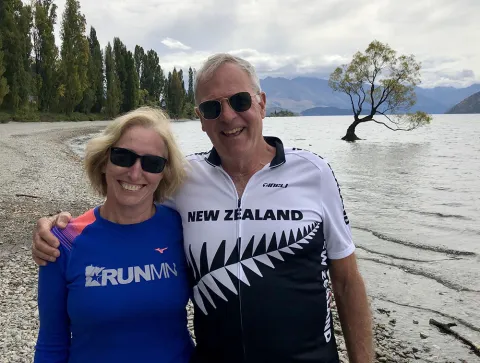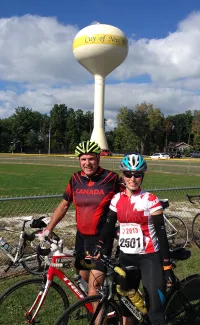Couple Supports Faculty’s Transdisciplinary Future

Around 200 times a year, whenever it rained, water would overwhelm an undersized pipe, spilling pollutants and waste into Nancy Creek, a tributary of the Chattahoochee River.
In 2002, when an environmental group called the Chattahoochee River Keepers filed a federal lawsuit, the Environmental Protection Agency ordered Atlanta to unsnarl the failing infrastructure. Harold Cunliffe (BASc'73, DULE'82), UBC alum and Atlanta-based real estate developer, joined a multidisciplinary commission appointed by the mayor to provide technical advice to the city.
Harold recalls a sense of urgency. "We were told, 'Each day we go over schedule will cost the city a million dollars in fines.'" Yet the stakes for over 400,000 Atlanta residents were even higher, considering the Chattahoochee sources over 70 percent of the city’s drinking water.
Stakes like these and those associated with complicated global challenges like social inequity and climate change have motivated Karen and Harold Cunliffe to donate $500K to Applied One, UBC Applied Science's critical new fundraising campaign. More than a building, Applied One will provide applied professionals with educational and research-based opportunities that more accurately approach the complexity of our age and the multi-faceted, integrated solutions this complexity demands.
"I think some very critical people will be educated in Applied One, students who will solve big societal problems," Karen says. "But we can't wait much longer; the sooner we get this project started, the better.
"Let's make this happen."
"The Real World"
Initially, the Cunliffes began by supporting a bursary previously established by Harold's father and other members of the Civil Engineering Class of '49. But then Karen and Harold learned about Applied One and recognized immediately its unique mandate.
Imagine engineers, planners and architects learning and innovating alongside nurses, lawyers and business students. Many university spaces today are more interdisciplinary in spirit than practice, collaborating in a fashion that’s more haphazard and reactive than systematic and integrated. Applied One, conversely, will see these disciplines pool their respective methods in technology, design and policy to work on challenges that no single field can address by itself.
“When we heard the Dean describe the Applied One campaign, we realized it will replicate what happens in real life," Harold says. "No engineer can avoid dealing with a whole spectrum of disciplines, and I imagine that's how it is for most vocations like engineering."
Engineering Family Tree
Understandably, as a teenager, Harold imagined his vocation to be engineering. His father Ray graduated from UBC civil engineering in '49, and his uncle Joseph in '50. Harold’s cousin Bob earned his civil degree in '73, and his brother David earned his in '78.
In the mid-2000s, Harold’s nephew also studied engineering, but he “fell off the wagon," Harold jokes. "Graham graduated as an electrical engineer." What’s more, his great aunt Muriel Cunliffe (BA'31, BSW'48) had an extensive UBC connection, too, in her role as director of the UBC School of Social Work in the late ‘60s.
Around that time, coincidentally, Harold was enrolled in high school and considering his post-secondary options. My father said, ‘'You don't have to decide right now, but why not get a basic education and decide what you'd like to do after that?'"
What did Harold's father consider a 'basic' or baseline education? Of course, a degree in civil engineering at UBC.
In 1982, after Harold supplemented his engineering degree with a UBC Diploma in Urban Land Economics (DULE), he and former civil engineering classmate Michael Kilgallon (BASc‘73 MBA’74) created The Pacific Group, a real estate development and investment company based in Atlanta.
Harold partly ascribes his real estate success to his engineering background.
Engineers have a way of looking at things differently from other professionals who often work in the development business.
When electing to invest in a residential or commercial property, the engineer-turned-developer asks himself a series of questions: What's structurally wrong with this asset? What could go wrong as we move forward? "I start with the premise that everything will prevent success, gradually eliminating one impediment at a time. 'Well, this part of the property isn't wrong, and neither is that. Let’s test the next step.’”
Back in 2002, as a member of an advisory committee charged with overseeing the remediation of Nancy Creek, that approach served him well, as did his dual experience as engineer and developer.
Communicating the Mission
When the City announced plans to the public, adjacent homeowners were concerned the fix would jeopardize their homes, creeks and the ground water supply.
Why? Engineers would bore a sixteen-foot diameter tunnel through the Atlanta bedrock, all to boost sewage capacity by collecting and diverting the rain-swollen burden of the narrow pipe. To satisfy themselves that the new tunnel was wide enough to accommodate future residential and commercial growth in the catchment basin, Harold and his fellow committee members translating that estimated growth into measurable terms (gallons). With regular meetings involving project engineers and contractors, the committee communicated this capacity to an array of residents, neighbourhood associations, politicians, urban planners, architects and developers.
Despite worries about delays and cost overruns, the team helped to deliver the Nancy Creek Tunnel a month ahead of schedule and tens of million dollars under budget. According to the Chattahoochee Riverkeepers’ website, the tunnel has dramatically cut the annual frequency of spills from 200 to few—practically none. To celebrate, Harold and his father attended the ribbon cutting with the mayor on New Year’s Eve in 2005.
Giving Students the Choice of Two Years or 40
Karen attributes this success to proficiency in collaboration and to understanding each other's disciplines, interests and needs. By integrating efforts and methods, a team becomes something larger than its members, which is precisely the approach of Applied One.
"From day one, Applied One will put people in groups so they can work and learn together and interact," she says. "Because that's how future generations will solve big problems."

According to the Cunliffes, their grown children, now business and science professionals, are financially secure and not reliant on their parents’ financial assistance. "They're doing fine," she says, “And if there are no engineers, we're holding out for the grandchildren. Our 15-year-old middle grandson is now considering post-secondary education and we are encouraging him to first get a basic education…”
Harold, whose civil engineering class recently had its 50th reunion, encourages his former classmates, fellow engineers and other successful alums to consider donating to Applied One and the future it promises generations of applied professionals. Private donations will be matched by the University.
“Judging from that event," he says, "everyone in my class is successful and has made lots of money."
He also believes that educational settings like Applied One will enable future generations to learn quickly, an essential skill in an era characterized by urgent challenges.
"Just imagine,” he says. “Students could learn in a few short years what took me 40 years.”



